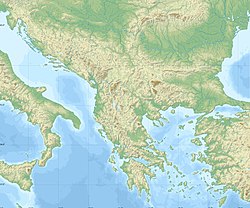
Back ستارا زاغورا Arabic ستارا زاجورا ARZ Stara Zagora AST Stara Zaqora Azerbaijani استارا زاگورا AZB Стара-Загора Byelorussian Стара-Загора BE-X-OLD Стара Загора Bulgarian Stara Zagora Catalan Стара-Загора CE
This article needs additional citations for verification. (January 2013) |
Stara Zagora
Стара Загора | |
|---|---|
City | |
From the top, View of the city from the monument "The Defenders of Stara Zagora", Sveti Nikolay Chudotvorets church, Zahariy Knyazheski library | |
|
| |
| Coordinates: 42°25′32″N 25°38′04″E / 42.42556°N 25.63444°E | |
| Country | Bulgaria |
| Province | Stara Zagora |
| Government | |
| • Mayor | Zhivko Todorov (GERB) |
| Elevation | 196 m (643 ft) |
| Population (2022)[1] | |
• City | 121,582 |
| • Urban | 142,746 |
| Time zone | UTC+2 (EET) |
| • Summer (DST) | UTC+3 (EEST) |
| Postal Code | 6000 |
| Area code | 042 |
| Website | www |
Stara Zagora (Bulgarian: Стара Загора, pronounced [ˈstarɐ zɐˈɡɔrɐ]) is a city in Bulgaria, and the administrative capital of Stara Zagora Province. It is located in the Upper Thracian Plain, near the cities of Kazanlak, Plovdiv, and Sliven. Its population is 121,582 making it the sixth largest city of Bulgaria, located North East of Plovdiv.
The city has had different names previously, including Beroe, Borui, Irenepolis, Eski Zagra, Augusta Traiana, etc. The earliest traces of civilisation date back to the 7th millennium BC. Some scholars believe that the ancient Thracian city of Beroe was located on the present site of Stara Zagora. In 1968, Neolithic dwellings from the mid-6th millennium BC were discovered in the town, which are the best preserved and richest collection in Europe of its kind and have been turned into a museum.
A high density of Neolithic and Chalcolithic settlements has been identified by researchers and a ritual structure nearly 8,000 years old has also been discovered. The first copper factory in Europe and a large ore mining centre were discovered, both over 7,000 years old. The original settlement dates from the 5th-4th century B.C under the name Beroe or Beroia, founded by Philip II of Macedon. It was renamed to Ulpia Augusta Traiana during Roman rule and became the second most important city, after Philippopolis. During Marcus Aurelius' rule, many buildings have been built, art and music developed and there were statues and inscriptions of Orpheus.
The Goths defeated the Romans in the Battle of Beroe in 250 AD. During the Gothic War between 376 and 382, the Roman general, Frigeridus promptly withdrew from Beroe to Illyria. At the end of the 6th century, Beroe was destroyed, but rebuilt under the name Veroia.
During the Middle Ages, Zagore is mentioned for the first time by Byzantine historians. Irene of Athens visited the town, rebuilding it and renaming it to Irenepolis, in honour of her. By the end of the 10th century, the city was in Bulgarian hands and acquired a fully Bulgarian character. Bulgarians called the town Borui (a modified form of the Thracian Beroe).
In 1371, the city passed to Ottoman Empire, but its earliest mention was in an Ottoman document from 1430. Plagues rampaged in the 18th-19th century, as well as famine and drought, livestock pestilence, and hailstorms destroyed all crops. During the Russo-Turkish War of 1877-1878, the town had devastating moments, which included a massacre of the local Bulgarians, in which thousands of people lost their lives, young women and girls being sold in the slave market of the Ottoman Empire.
In modern times, the city is relieved, as a growing city. The economy is developing like major cities in Bulgaria, with one of the highest wages in the country, high GDP in comparison with many Bulgarian cities, low unemployment of about 4%. The city is also located near the largest energy industrial complex, Maritsa Iztok Complex, where many of the people from Stara Zagora are employed.






